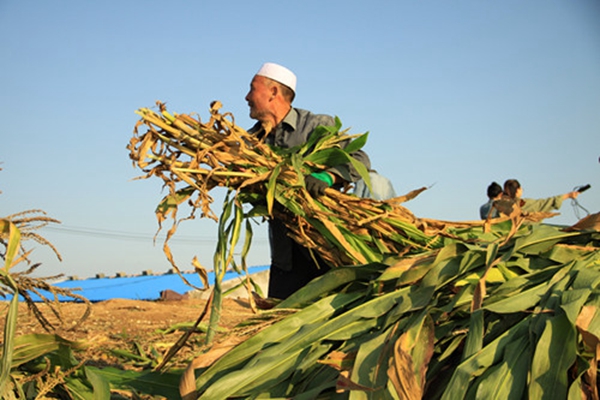


Fancy a Kindle? Take the Long March quiz
 |
|
A farmer in Xieling village puts cornstalks into a machine to crush them. [Photo provide to chinadaily.com.cn] |
The brand new buildings of Xieling village in Kongtong district, Pingliang city, Gansu province are truly an eye-opener for those who see it for the first time.
In one community, houses with red roofs were erected, a fancy public square with fitness equipment has been built, and power transmission towers stand there like guardians of the village.Some 200 meters away, a row of cowsheds with shining blue roofs can be seen, with fodder store houses and a sterilizing room on the side. In another community just across the road, a crescent can be seen rising above the roof of a mosque.
The village has three communities, two for ethnic Hui people, and one for Han people. More than 60 percent of residents in Xieling village are Hui people, the most widespread ethnic minority group in China.
Here, 2,200 meters above the sea level on the mountainous region in eastern Gansu province, people have started to embrace a new life.
Ma Wencheng, a 48-year-old farmer, said in his memory, his ancestors moved to this area over a century ago. Their life can be summed by three words - "a stick, a pair of rain shoes and a worn-out cotton-padded jacket".
He explained that, as the red soil commonly seen in the area becomes especially muddy on rainy days, people have to use a stick and wear rain shoes to walk in the muddy field, and the temperature difference is so great that one has to wear cotton-padded jacket to keep warm in the morning and evening.
Life used to be harder and more primitive, said Ma. Many villagers lived in cave houses in the past, and cows they raised just roamed about on the mountain. As the farmlands are not suitable for farming, most villagers lived below the poverty line.
Life has changed a lot since villagers moved to their new homes.
Since 2015, a resettlement project has brought together 76 households in the village which were scattered around the mountain in the past. Their new homes are located on the mountain top which was leveled to make a flat space.
Cows are now raised in cowsheds and a new species of corn imported from Mexico can produce more for the animals. The cornstalks are crushed and stored under the soil and a film to ferment for a week, which makes them more delicious for the cows.
And due to the concentrated raising method, the number of cows each family has more than doubled to 10. Each of the cows can bring around 10,000 yuan ($1,500) to the farmer. That made an important contribution to the dramatic drop in the poverty rate from more than 50 percent to less than five percent in one year.
Utilities have also been much improved. A new cement road connects the village with the nearest town of Kongtong, and each household gets access to tap water and electricity.
Fancy a Kindle? Take the Long March quiz
